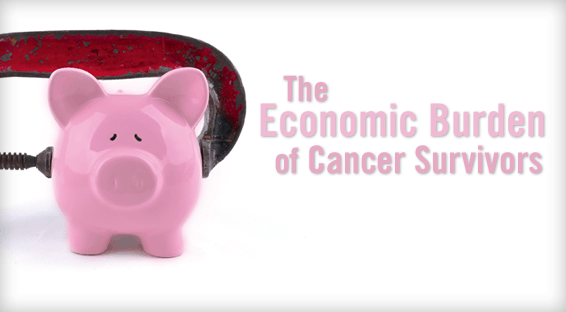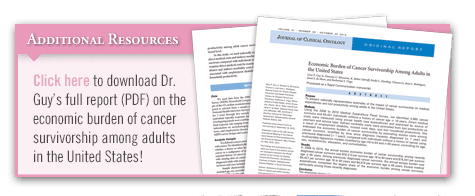According to recent estimates, about 13.7 million people in the United States with a history of cancer were still living in 2012. “The prevalence of cancer survivors has increased substantially over time,” says Gery P. Guy Jr., PhD, MPH. “Even more cancer survivors are expected as advances are made in treatment and early detection and as life expectancy continues to increase.” As the number of cancer survivors grows, it is important to understand how medical expenditures and lost productivity affect these individuals. This includes exploring the role of employment disability, hours worked, and
missed work days.
In the past, studies of medical expenditures used cancer registry data, administrative claims, and other sources to describe the economic burden of patients who have survived cancer. However, analyses of expenditures on a national level tend to only include cancer survivors who are receiving cancer-related healthcare. Few studies have assessed multiple components of the economic burden of cancer survivorship, and most of these were conducted in a single state.
“To gain a better perspective on this issue,” says Dr. Guy, “we need to quantify medical expenditures and the indirect morbidity cost of lost productivity among adult cancer survivors of all ages on a national level.” To address this need, Dr. Guy and colleagues conducted a study using the 2008 to 2010 Medical Expenditure Panel Survey to compare the economic burden of adult cancer survivors with individuals who did not have a history of cancer. The study, published in the Journal of Clinical Oncology, looked at the lost productivity that is associated with employment disability, missed work days, and lost household productivity.
Considerable Costs
In the analysis, researchers compared 4,960 cancer survivors with 64,431 adults without cancer. According to the results, the annual excess economic burden of surviving cancer among recently diagnosed patients was $16,213 per survivor between the ages of 18 and 64 and $16,441 for those aged 65 and older. Among previously diagnosed cancer survivors, the annual excess burden was $4,427 each for those under the age of 65 and $4,519 for those aged 65 and older. “Our study demonstrates that the economic burden of cancer survivorship is substantial and long lasting,” says Dr. Guy. “Although this burden is greatest shortly after patients are diagnosed, it’s also high for years after the diagnosis.”
The largest source of payment for younger cancer survivors was private health insurance, while Medicare accounted for the largest share among those aged 65 and older. Ambulatory care accounted for the largest share of medical expenditures for survivors between the ages of 18 and 64, whereas inpatient care had the largest share among the oldest survivors (Figure 1). In aggregate, annual medical expenditures were $25.2 to $41.7 billion for cancer survivors aged 18 to 64 and $37.3 to $48.1 billion among survivors aged 65 and older. The largest share of aggregate net expenditures came from ambulatory care, followed by inpatient care, prescription medications, and other services.
Productivity
The study also found that the plausible range of aggregate net productivity loss per year was $9.6 to $16.0 billion among younger survivors and $8.2 to $10.6 billion for older survivors. The largest share of aggregate lost productivity across both age groups came from employment disability, followed by missed work days and lost household productivity (Figure 2). “Cancer survivors were more likely to incur higher indirect morbidity costs than those without the disease,” Dr. Guy says. He adds that the excess lost productivity was greater for working-age adults and those recently diagnosed with cancer.
Significant Implications
“The number of cancer survivors is projected to increase to nearly 18 million by 2022,” Dr. Guy says. “This means that the economic burden of cancer will also likely increase. To help reduce this economic impact, multifaceted prevention strategies will be needed. This includes conducting more research, providing more education, making policy changes, and sustaining intervention programs.” He notes that data from the study may help guide the development of comprehensive intervention programs in the future.
Given the expected changes in insurance as it relates to the Patient Protection and Affordable Care Act, it will be important to monitor medical expenditures by source of payment. “We will need additional analyses of the economic burden of cancer survivorship to monitor trends and determine how interventions and policy changes are impacting patients,” says Dr. Guy. “The hope is that this information can be used to improve the quality of the cancer survivorship experience and perhaps decrease the burden of this disease throughout the U.S.”




 TimH
TimH